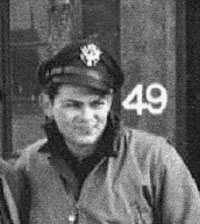357th FG Profile

Lt. Alvin Pyeatt

Spring 1944
Modeler Tips:
Side View Notes:
A. Rear red band on propeller boss extends onto spinner to leading edge of blades when in neutral pitch. Determine width of yellow band by dividing remainder of spinner evenly.
B. “Scrappy” in deep yellow, bordered in red. Lettering occupies lower strip panel and overlaps lower seam.
C. Name placard, includes names of pilot and armorer but lists only ranks of crew chief and assistant crew chief.
D. Three bomb-style mission marks over a broom, followed by two swastikas on white circles bordered in red..
E. White recognition stripes were of standard widths on wings, vertical & horizontal stabilizers for early-1944 ETO Mustangs.
F. Tail Number- “36” on fin, “960” on rudder in USAAC yellow.
G. Same as item “E”, above.
Upper & Lower View Notes:
H. Same as items “E” and “G”, above.
I. Width of checker reduced on underside in order to fit evenly on the narrow surfaces of the chin scoop area. J, K, L. Red, Green, Yellow navigation lights- circular and flush with wing panel.
M. Formation Lights- Red (Port) and Green (Starboard)
Overall Modeling Tips:
*This aircraft wore dark olive green upper camouflage over US Medium Gray. There were no mirrors or antenna wires installed on this aircraft. Some decal manufacturers have included black and white invasion stripes in their diagrams of this aircraft which seems very unlikely since it was the tragic fate of Lt. Pyeatt to be killed in this aircraft in Europe after crashing as a result of damage inflicted by FW-190s on March 16, 1944. See the interview with Mr. Hoyt Parmer, a 357th FG Armorer, under “Stories of the 357th” for more about Lt. Pyeatt and how highly regarded he was among his squadron mates.
*After building several 357th A/C over the past 30 years, I recommend painting the nose area forward of the exhaust cutout yellow when the flat features are painted. Carefully cut away the yellow squares from the checkerboard decal and apply the remaining strip of red checkers to the nose. This method significantly reduces the potential for bubbles, and wrinkles plus it makes exact alignment of the decal easier.
*Prior to assembly, wash clear plastic parts with a mild glass cleaner and gently wipe dry. Then use a Q-Tip to evenly spread clear liquid floor wax (Future Brand seems to get the best results) on both inside & outside. Protect from dust and let dry for at least 2 hours. The wax fills in microscopic flaws and creates an even gloss that is clearer & shines brighter than the original plastic underneath.

1st Lt. Alvin Pyeatt’s P-51B Mustang “Scrappy”
Repli-Scale Decal Sheet 48-5055

